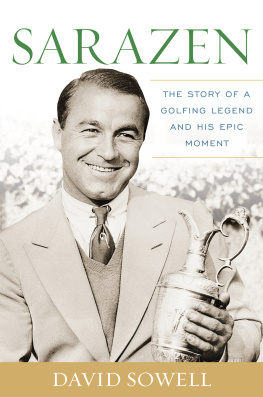
Sowell gives us the Masters in full flower.
Booklist
We have always wondered why the Masters is a tradition unlike any other. David Sowell has an answer in his new book. He covers the magical moments of the good, the grand, and the also-ran on a course that itself is a memorial to Bobby Jones.
Sidney L. Matthew, author and producer of Life and Times of Bobby Jones
An entertaining read that enthusiasts will enjoy.
Library Journal
Every kind of book on the Masters that could be written had been written, until David Sowell came along. He takes a route previously not taken, giving each of the eighteen holes of Augusta National its own fifteen minutes of fame.
Furman Bisher, the late legendary sports columnist for the Atlanta Journal-Constitution who covered the Masters for more than sixty years
The Masters
A Hole-by-Hole History of Americas Golf Classic
Third Edition
David Sowell
University of Nebraska Press | Lincoln
2019 by David Sowell.
Cover designed by University of Nebraska Press; cover image: 13th Hole at Augusta National Golf Club 2018 Kyodo via AP Images.
All rights reserved.
Library of Congress Cataloging-in-Publication Data
Names: Sowell, David, 1948 author.
Title: The Masters: a hole-by-hole history of Americas golf classic / David Sowell.
Description: Third Edition. | Lincoln, Nebraska: University of Nebraska Press, [2019] | Includes index.
Identifiers: LCCN 2018037065
ISBN 9781496212832 (cloth: alk. paper)
ISBN 9781496224972 (paperback)
ISBN 9781496215017 (epub)
ISBN 9781496215024 (mobi)
ISBN 9781496215031 (pdf)
Subjects: LCSH : Masters Golf TournamentHistory. | GolfUnited StatesHistory.
Classification: LCC GV 970.3. M 37 S 69 2019 | DDC 796.352/66dc23 LC record available at https://lccn.loc.gov/2018037065
The publisher does not have any control over and does not assume any responsibility for author or third-party websites or their content.
To all those who love the Masters
Contents
I would like to first thank my wife, Susan, whose steadfast support and encouragement made this undertaking possible. I would also like to express my deep gratitude to our sons, Brett and Brandon, who are both stretched thin in their own careers but always managed to find the time to provide support and assistance when Dad needed it.
Also, many thanks to Robert Taylor at the University of Nebraska Press and to my agent, Robert Wilson, at Wilson Media.
Last but certainly not least, I will always be indebted to my best friend since high school, Dr. Cordell Scott, who infected me with the golf bug and despite my erratic play has put up with me as his partner in tournaments for more than thirty years.
Six days before Christmas in 1933, it was announced that a new golf tournament would take place in the spring. The tournament would be held on a new course in Georgia, the Augusta National Golf Club, and it would be hosted by the clubs founder, who happened to be the greatest golfer of all time, Bobby Jones. The game of golf has never been so enriched and has never been the same.
Bobby Jones was one of the most celebrated figures in what was called the golden age of sports. From 1923 through 1929 he won nine major golf titles. In 1930 he captured that eras Grand Slam by winning the British Amateur, the British Open, the United States Open, and the United States Amateur. Up until this incredible feat, no golfer had ever won more than two of these prestigious tournaments in a single year.
In the fall of that year, after announcing his retirement from competition at the age of twenty-eight, Jones remained very much in the public eye. He signed on with Warner Bros. studios to make golf instructional films that were shown in movie theaters across the country. The films were a huge success, allowing a whole generation of golfers to see his beautiful swing at actual speed and in slow motion.
Jones had another endeavor he wanted to pursue, and that was to build what he called his dream course. In the spring of 1931 friends of Jones in Augusta, Georgia, suggested that he drive over from Atlanta, his hometown. The friends wanted him to look at a property, Fruitlands Nurseries, which was for sale. This 365-acre tract was once the site of an indigo plantation that had been purchased in 1857 by a Belgian baron named Louis Mathieu Edouard Berckmans. The baron, who was a horticulturist, and his son Prosper, a professional agronomist and horticulturist, had turned the old plantation into one of the Souths finest commercial nurseries.
When Jones came to the property to inspect it, he was driven down the impressive entranceway, Magnolia Lane, to the stately preCivil War manor house. He then walked around to the rear of the house and saw before him a beautiful canvas upon which to create his masterpiece: stands of tall pines with flowers and shrubs and vast stretches of open ground that ran down a long hillside toward a stream, Raes Creek. A deal for the property was struck, and soon afterward the Augusta National Golf Club was formed.
Jones was an exceptional achiever off the golf course as well. After he earned a degree in mechanical engineering at Georgia Tech in just three years, he received a BS degree from Harvard, where he had spent two years studying English literature. The son of a lawyer, Jones subsequently entered Emory University law school in Atlanta. During his second year at Emory, he passed the Georgia Bar Exam and became a lawyer.
What made Jones a truly exceptional man, in addition to his academic accomplishments, was that he had also been blessed with an attribute often in short supply in the populationthe gift of common sense. While he had an abundance of knowledge about what was required to make a golf hole truly outstanding, he knew that he would need first-rate support if he was to make his dream course the great layout he wanted it to be.
One of the first steps Jones took after the Augusta National Golf Club was organized and he had been named its president was to engage the services of renowned Scottish golf course architect Alister MacKenzie. Jones had played Cypress Point on the Monterey Peninsula, one of the courses in the United States that MacKenzie had designed, and he had been deeply impressed.
Another factor in Joness selection of MacKenzie was that he wanted Augusta National to have the playing characteristics of the Scottish courses he had come to admire so much. Jones wanted the natural contours of the land to dictate the strategy of the holes. The fairways would be wide and quick, the fairway and greenside bunkers would be kept to a minimum, and the greens would be large, undulating, and fast.
Another key player in the founding of Augusta National was Clifford Roberts, a Wall Street investment banker who handled the financing and operational details of the club. In a few short years Roberts would display an as yet untapped talent, which was showing the world how to put on a first-class golf tournament.
The course formally opened for play in January 1933. Later that year, the inner circle of the club decided that beginning in the spring of 1934, the club would play host to an annual invitational tournament in which the top players in golf would participate. Cliff Roberts wanted the event to be called the Masters, but Jones thought the name too presumptuous, so the event took the official name of the Augusta National Invitational. But a large number of sportswriters had picked up on Robertss preferred name, and they referred to the tournament as the Masters from the very beginning. In 1938 Jones finally agreed to change the tournaments name to the Masters.
Next page











